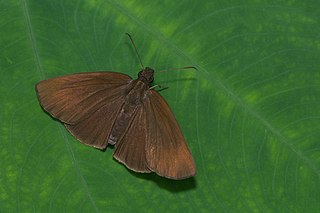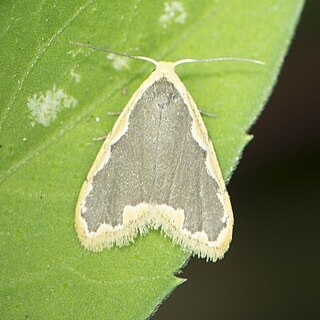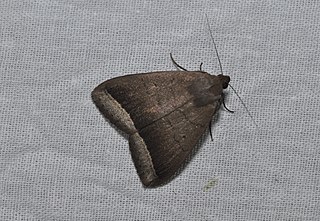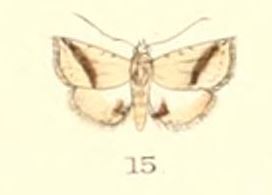
Psolos fuligo, the dusky partwing or coon, is a species of butterfly belonging to the family Hesperiidae. It is found in India. The tips of the forewings diverge outward and is a feature that is clear when they rest on vegetation.

Spalgis epius, commonly known as the apefly, is a small species of butterfly found in the Indomalayan realm that belongs to the lycaenids or blues family. It gets its name from the supposed resemblance of its pupa to the face of an ape.
Coproptilia is a genus of moth in the family Lecithoceridae. It occurs in East and Southeast Asia.

Amyna is a genus of moths of the family Noctuidae erected by Achille Guenée in 1852.

Avitta is a genus of moths of the family Noctuidae described by Francis Walker in 1858.

Asota is a genus of moths in the family Erebidae first described by Jacob Hübner in 1819. Species are widely distributed throughout Africa, India, Sri Lanka, Myanmar, the Malayan region and tropical parts of the Australian region.
Pieter Cornelius Tobias Snellen was a Dutch entomologist.

Diduga flavicostata is a species of moth in the family Erebidae first described by Snellen in 1879. It is found on Java, as well as in Australia, India, Sri Lanka, Myanmar, Malaysia, China and Japan.
Nymphicula christinae is a moth in the family Crambidae. It was described by David John Lawrence Agassiz in 2014. It is found in Australia, where it has been recorded from Queensland.
Calamotropha oculalis is a moth in the family Crambidae. It was described by Samuel Constantinus Snellen van Vollenhoven in 1893. It is found on Java and Sri Lanka.

Elymnias nesaea, the tiger palmfly, is a butterfly in the family Nymphalidae.
Perimeceta incrustalis is a moth in the family Crambidae. It was described by Snellen in 1895. It is found on Java and in Australia, where it has been recorded from northern Queensland.
Dichomeris deceptella is a moth in the family Gelechiidae. It was described by Snellen in 1903. It is found on Java.
Dichomeris viridella is a moth in the family Gelechiidae. It was described by Snellen in 1901. It is found on Java.
Coproptilia diona is a moth in the family Lecithoceridae. It was described by Chun-Sheng Wu in 1994. It is found in Jiangxi, China.
Coproptilia tawiensis is a moth in the family Lecithoceridae. It was described by Kyu-Tek Park in 2009. It is found on Tawi-Tawi in the Philippines.
Thubana costimaculella is a moth in the family Lecithoceridae. It was described by Snellen in 1903. It is found on Java.

Simplicia bimarginata is a moth of the family Erebidae first described by Francis Walker in 1864. It is found in India, Sri Lanka, Malaysia, Indonesia, New Guinea, Singapore, Sumatra, Borneo, the Philippines and Sulawesi.

Eublemma pudica is a moth of the family Erebidae first described by Snellen in 1880. It is found in Sri Lanka, India, Fiji and Australia.

Dudusa is a genus of moths in the family Notodontidae. It was first described by Francis Walker in 1865. Moths in genus Dudusa are large, with yellow to ochre forewings and brown hindwings, and show little sexual dimorphism. Species occur in Asia, with the most diversity in Indochina.








